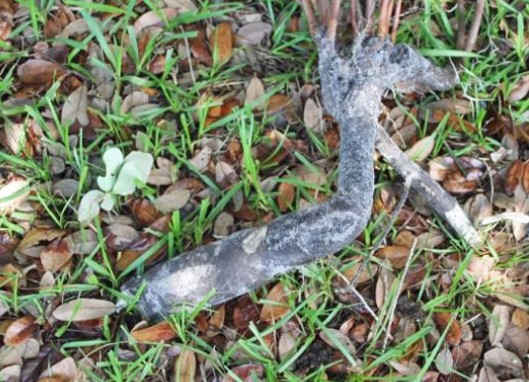These woody species are usually multi-stemmed and stems arise from a very deep taproot that can be as big as 3 inches in diameter (Figure 3).

Figure 3. Pawpaw roots have a very large taproot, and once established are extremely difficult to control.
Leaves are present from early April through October, but may exist through December in some areas of the state. Flowering occurs in April to May, and seed production is reportedly low. Flowering often occurs before leaves begin to grow in the spring (Figure 4).

Figure 4. Flower formation in pawpaw typically occurs before leaves begin to grow in the spring. Photograph by B. Sellers.
As with lantana, pawpaw control appears to be somewhat difficult. Mowing typically results in an increase in the number of stems, and hand digging is likely the only “mechanical” method of removing pawpaw plants from improved pastures, as they do not tolerate root cutting. Considering the long and deep taproot of pawpaw, control with a single herbicide application should not be expected.
Experiments were conducted in a pasture that was heavily infested with pawpaw in central Florida. Herbicide treatments included 1 qt/A triclopyr (Remedy Ultra), and triclopyr at 1 qt/A followed by triclopyr at 1 qt/A 6 months later, Pasturegard HL at 1 qt/A, and Pasturegard HL at 1 qt/A followed by an additional 1 qt/A 6 months later. Methylated seed oil (MSO) was added to each spray mixture at 1% v/v. The initial treatment was applied in May and the sequential treatments were applied in late November. To evaluate the level of pawpaw control, the number of pawpaw stems were counted in each plot on the day of application, 6 months after treatment (MAT), and 12 MAT.
Living stems in plots were very low at 6 MAT (at the time of the sequential application), with all treatments providing >90% reduction in stems, as compared to pre-treatment numbers. However, stems densities increased by 12 MAT (6 months after sequential treatment). A single application of Remedy or Pasturegard HL resulted in 49 and 40% less stems compared to pre-treatment stem counts, respectively. A sequential application of either herbicide resulted in >70% reduction in pawpaw stems counts compared to pre-treatment levels. Although stem densities did not differ significantly between Remedy and Pasturegard HL plots, pawpaw plants were typically shorter in plots treated with Pasturegard HL, indicating that regrowth of pawpaw plants was slower when treated with this herbicide as compared to Remedy.
Source: ufl.edu